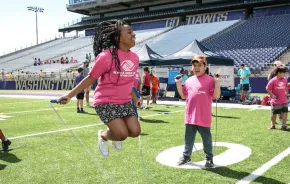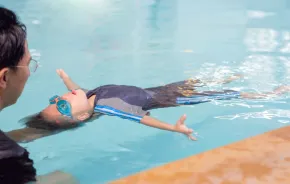
As I write, I’m looking out the corner of my eye at the source of much consternation. It’s the trampoline in our backyard. I know it’s a risk. The lawyers would call it an attractive nuisance. Indiana University researchers made news this spring when they released findings that between 2002 and 2011 more than one million people were treated in the emergency room for trampoline-related injuries, 93 percent of them age 16 years or younger. The average age of an injured person in the ER is about 9 years old. That’s emergency room visits, not just minor bang-ups.
We bought our trampoline a couple of years ago after seeing how much fun the neighbors were having with theirs. Maybe it was keeping up with the Joneses, but I loved how the “Joneses’” kids were exercising in fresh air. While my kids are athletic and active, I looked forward to demoting our video game console in the household popularity contest.
So how do I reconcile something that encourages free play and gets the kids’ energy out with the fact that trampolines in households are a proven hazard? Even with modern improvements like pads over springs, or no springs at all, plus enclosures, some medical experts still say they are a hazard that should be banned from recreational use.
The medical pros are imploring parents to listen. So I set out to look at the injury statistics and recommendations from the perspective of a “user.” I wanted to understand, then hopefully convey to other parents, exactly why so many kids get hurt — and, most important, what we adults must do to minimize the risk of injury. Again from the perspective of a user, meaning a mom who has yelled at my older kids more times than I count to stop trying to double-bounce their 7-year-old brother high into the air.
Bouncing can break bones
Since the trampoline mat (the fabric that stretches across the frame) is moving, it is inherently unstable to land on. “Anytime you are planting and twisting on a moving surface you’re at high risk for injuries that need more than TLC,” says John Lockhart, M.D., an orthopedics and sports medicine physician at Seattle Children's Hospital. The higher a kid jumps, the greater the chance he will come down wrong.
Lockhart adds that people mistake the fabric mat as being easy on kids’ bones and joints. But particularly when you have more than one person jumping (which you are not supposed to do, and which I will address later) the force of those double bounces can do serious damage.
For example, my friend’s 10-year-old son broke his ankle jumping with buddies on a trampoline last summer. Initially it looked like a sprain. But when the ankle couldn’t bear weight, my friend knew it was time to take him in to the doctor. He had broken the bottom of his tibia, including growth plate involvement.
But it’s not just ankles and knees. The Journal of Pediatric Orthopaedics report found about 60 percent of fractures are located in the upper extremity, which Lockhart explains is due to awkward landings that happen after flying high in the air.
One trampoline manufacturer calls jumping a low-impact exercise. On its website, the company goes on to say, “The repetitive action of jumping … builds the musculoskeletal system.” But Lockhart points out the contradiction in the claims: “The impact would, in fact, be the part that would potentially increase bone density. And then they claim it is a low-impact exercise — it wouldn’t seem like they could claim both.”
The more the merrier … not!
Kids are, of course, attracted to the social aspect of trampolines. The AAP reports that 75 percent of trampoline injuries occur when multiple people are jumping on the mat. The smallest and youngest participants are usually at greater risk for significant injury, specifically children 5 years old or younger. As reported in the Journal Pediatrics, “Heavier users create more recoil of the mat and springs and greater upward impaction forces than smaller users can generate on their own.” The AAP says children under 6 should not use trampolines.
In case you’re thinking that, given all the risks social adolescents and teens may take, this is a good one, consider some other numbers. The Indiana University report, a compilation of data from the National Electronic Injury Surveillance System, found that the average age of axial skeleton injuries (spine, skull/face, rib/sternum) was 16.5 years old. Add in the risk of collision injuries, when someone lands on another’s foot or jumpers knock heads. Experts emphasize, just one kid at a time.
Forget flipping
The most catastrophic injuries can happen when someone lands on their head or neck — failed somersaults or flips cause hyperflexion or hyperextension of the cervical spine. And this can happen even with falls on the mat, not just falls off of the trampoline. “Netting and other safety equipment indicates no reduction in injury rates,” according to the AAP.
After its invention in 1934, the trampoline was used by gymnasts, divers and other athletes as a training tool. Pilots and astronauts came to adopt them for the experience of unpredictable body positions during flight. Since the 2000 Sydney Games, trampoline has been an Olympic event.
But the people using trampolines in those instances were all pros. I venture that most kids playing at home are not being spotted (though spotters are a recommendation of the AAOS), which means kids have no business doing flips on the trampoline.
Trampolines are not toys. If parents remember that, then most of the injury-prevention recommendations are common sense. There are many other useful tools that professionals in various fields have developed, from scuba diving suits to AEDs, but we’re not turning our kids loose with them to use as playthings. Treat the trampoline with the respect that 100,000 injuries a year dictate it deserves.











